
This site is for all enthusiasts of Swiss
Railways, especially those in the Manchester and
north-west England area.
Untermutten scenes
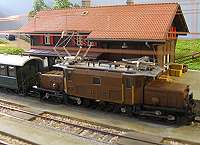
Crocodile on the 'Mixed' at Untermutten.
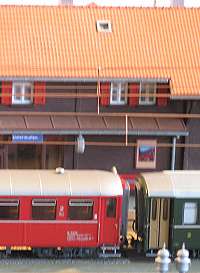
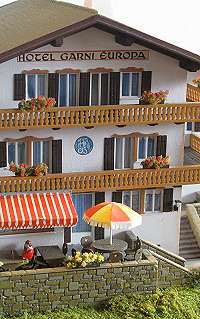
The hotel inspired by Hotel Grischuna by the station at Filisur.
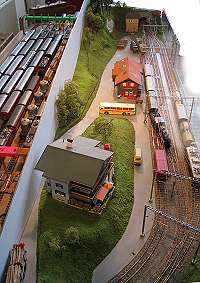
General view of the layout.
Below - the real Mütten in Switzerland
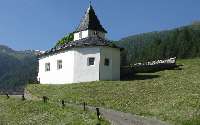
Mütten church & the road to Obermütten
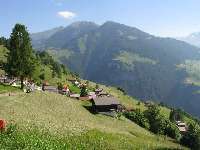
Mütten village viewed from the church
Exhibitions attended, 2007-
March 2007 SRS AGM Bristol
December 2007 Mirfield
March 2008 SRS AGM Derby
September 2008 Halifax
14-15 March 2009 - Narrow Gauge North, Rawdon
Easter 2009 - York Model Railway Show
12-13 September 2009 - Glossop
10-11 October 2009 G-Whizz Garden Rly Exhibiton at Lytham St Annes
24-25 October 2009 - Hazel Grove
6-7 March 2010 - Macclesfield
March 2010 SRS AGM Derby
8-9 May 2010 - Dukinfield
22 May 2010 - Mirfield
30-31 October 2010 - L&Y DCC MRG at Rawtenstall
5-6 February 2011 - Rochdale
19-20 March 2011 - Heywood
14-15 May 2011 - Derby
22-23 October 2011 - Warrington
10-11 December 2011 - Wigan
7/8/9 April 2012 - York 50th Show
28-29 April 2012 - Liverpool
12-13 May 2012 - Cleethorpes
15-16 September 2012 - Fleetwood
10-11 November 2012 - Newcastle
12-13 January 2013 - St Albans
20th April 2013 - 009 AGM, Rainford
5/6 October 2013 - Manchester
12/13 October 2013 - Barrow in Furness
29/30 Nov/1 Dec 2013 - Wakefield
22/23 Feb 2014 - Chapel-en-le-Frith, NMDRM
8 March 2014 - Narrow Gauge North
15 March 2014 - SRS AGM, Derby
22/23 March 2014 Perth Green, Jarrow
5/6 April 2014 Sheffield -SMRE
17 May 2014 Mirfield
13/14 September - 2014 Glossop
Feb 2015 - Eurotrack
28/29 March 2015 - London Alexandra Palace
14/15 Nov 2015 Spalding
December 2015 ERA Birmingham
March 2016 SRS AGM Derby
June 2016 Bakewell
September 2016 Blackburn
October 2016 Sheffield
1 April 2017 - 009 AGM Rainford
April 8/9 2017 - TrainWest Corsham, Wilts SN13 9DN
April 29th 2017 - Southport Model Railway Exhibition,
May13/14 2017- Apedale, North Staffs ST 15 9LB
May 20th 2017 - Mirfield
Oct 28/29 2017 - Hazel Grove
Nov4/5 2017 - Crewe (Alsager MRC)
June23rd/24th2018 - Perth Model Rly Exhibition,
Updated June 2018
Untermutten - by Dave Howsam
Scale 3.5mm/1ft, Gauge 12mm, Size 7’ x 3’ (Modified
October 2013)Video made by Dave Long at the 2010 Macclesfield exhibition: the DVD with scenes on all layouts is available, along with many other railway DVDs, at railwayfilms.co.uk.
Below is the full article on Untermutten which would have appeared in Continental Modeller April 2012 had I sent the final version and not the first draft of the write up!
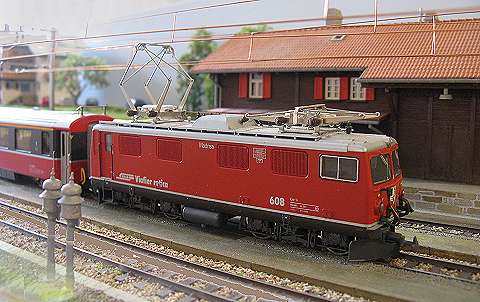
In 1984 I built a very
small layout with a passing loop, purporting to represent
the narrow gauge Rhaetian Railway in South East
Switzerland. The track plan did not follow any of
the prototype stations and the overhead was modelled using
individual masts rather than the span variety.
Nonetheless the model served its purpose and operated well
for a number of years as well as forming part of a large
joint H0m layout over 35' in length. My
section was called Obermutten being named after a small
locality above Thusis which can be reached by post bus in
summer. {The layout appeared in The Modeller Book of
Narrow Gauge bfore being sold in the early 90s}.
Perrapswil, my HO Swiss layout, was built and exhibited
while my H0m rolling stock (mostly Bemo products) lay in
boxes unused. I did not want to part with the models
so it was decided that a small exhibition layout should be
built so the stock could have an airing and we could
attend shows with a lot less effort and stress than
Perrapswil could cause, the latter taking two weeks to
dismantle at home, exhibit and re-erect and re-stock at
home.
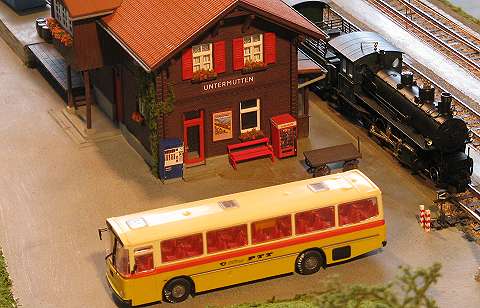
The location for the new
model would again be a fictitious location on the Albula
line and would be called Untermutten. My idea was to
have the layout on just two baseboards each 6'2" long with
the overhead catenary confined to just one board, to
allow for a quick and easy set up at exhibitions. The
design necessitated the front track being as near the edge
of the layout as possible (allowing just enough space for
the span masts) so that a combination of radius 1 and 2
Bemo set track curves would form a continuous run.
The track was to curve away symmetrically at both ends,
under a bridge and into a tunnel. Careful planning
and design then came to nought as I discovered that whilst
the station board fitted in my car, the front seat
passenger would endure very uncomfortable journeys
to and from exhibitions. There was nothing for it
but to reduce the length to 6'. This meant I could
not quite get a four-coach train (plus gepackwagen) in the
station loop and so a third baseboard would have to be
fashioned to go across the end for the tunnel curve.
So much for keeping baseboards, baseboard joints and set
up time to a minimum. The original curved point location
can be seen in the photograph which shows the early stages
of development.
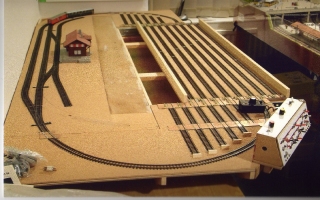
The station board was
built using nominal 3" x 1/2" softwood frame and 9mm ply
deck; the opportunity taken to reduce the framework in one
corner to allow the scenery to come below track level. The
plywood was covered with 1/16" cork and the Bemo-branded
code 70(Shinorara) trackwork put down. The legs,
which bolt under the baseboard for transportation, were
set at a height of 3'9" (it was intended to stand above
Perrapswil, originally) and locate into pockets to avoid
the need for bolts. Legs are braced, when
erected, by two removable diagonal struts located by
30mm M6 bolts, adopted as standard throughout, and fixed
into captive M6 tee nuts, again standard throughout. The
latter really makes setting up and dismantling
easier. Any non-standard bolt lengths are clearly
marked at the appropriate fixing hole. The
baseboards are aligned with brass cabinet makers' dowels
using M6 bolts to join the boards, all nuts being
captive "tee nuts". Each end of the layout is
colour coded and this is reflected on all items to be
attached using symbols of the appropriate colour.
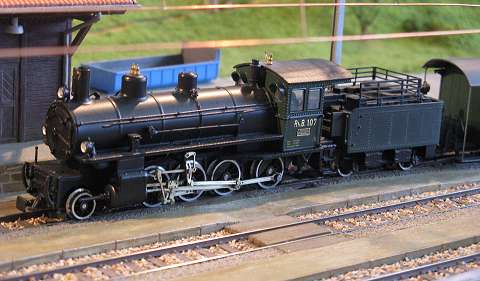
An eight-road traverser
was constructed on the rear board using extended
heavy-duty drawer runners. Alignment of roads is by brass
rod and tube, originally one for each rail was used but
this took too long at exhibitions so now common outer
rails are connected by a wire, meaning that only two brass
bolts have to be aligned instead of four. A 'bridge'
was made for each end of the traverser. This is high
enough to clear pantographs and the road numbers were
labelled on the bridge. It was then drilled and
lengths of dowel are inserted to form vertical stops
resting between the running rails. The idea was that
should anything be pushed, accidentally, to the end of the
road whilst the traverser was out it would be prevented
from crashing to the ground. This precaution has
never been needed, but we continue to use it 'just in
case'. The dowel rod is lifted to clear a departing
or arriving train (and the pantograph) and held up by a
sprung clothes peg. The station tracks are connected
to those of the traverser by 330 and 376 mm standard Bemo
curves. By using the smaller radius only at the
centre of the curves I found I could get all stock round
without any fouling of pipes etc. Track joins
between boards the rails are soldered to copper-clad
strips, the brass dowels providing rail alignment.
The traverser bolts down for transportation; it travels
upside down with Untermutten on top and all baseboard ends
(and track) are protected by bolt-on pieces of ply.
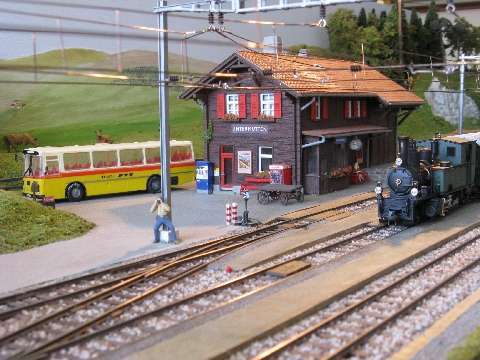
The points are
powered by Bemo point motors under the baseboard using an
arm made of brass strip for linkage and as all the
contacts on the motor are used to give route indication,
signal routing and frog polarity each motor has a 15-way D
plug for easy interchange. A couple of spare motors,
already wired, are always taken with the layout. The
point lanterns, with a new wire for the Shinohara points,
are worked by the points. Five Repa/Bemo uncouplers
with a replacement, smaller, top are strategically placed
and are worked by rotary switch for selection and
momentary switch for operation.
After a period of testing trackwork and controls and the servicing of stock unused for over ten years it was time to move on to the scenic side. Ballasting was carefully carried out using a mixture of Woodland Scenics ballast, water and diluted PVA glue applied applied by a 5ml syringe of the type supplied with childrens' medicine. Landscaping, over expanded polystyrene, plaster bandage, and painted plaster, uses Woodland Scenics and Anita Decor products, whilst the majority of trees, fashioned from sea moss, again make use of Anita Decor products for foliage. A Sopa tunnel mouth and a bridge built from Wills coarse stone provide a way for the trains to disappear from sight. The overhead equipment all comes from the Sommerfeldt range with their finer wire being used for the catenary. The RhB masts and fine wire have proved to be a lot less troublesome and more robust than the SBB version on Perrapswil. I may well be tempting fate when I say that I have never had to use the soldering iron at an exhibition yet. To be fair my, H0 layout had 25 pieces of catenary spanning joints which makes tensioning, and retaining the tension in the overhead wires, much more difficult.
After a period of testing trackwork and controls and the servicing of stock unused for over ten years it was time to move on to the scenic side. Ballasting was carefully carried out using a mixture of Woodland Scenics ballast, water and diluted PVA glue applied applied by a 5ml syringe of the type supplied with childrens' medicine. Landscaping, over expanded polystyrene, plaster bandage, and painted plaster, uses Woodland Scenics and Anita Decor products, whilst the majority of trees, fashioned from sea moss, again make use of Anita Decor products for foliage. A Sopa tunnel mouth and a bridge built from Wills coarse stone provide a way for the trains to disappear from sight. The overhead equipment all comes from the Sommerfeldt range with their finer wire being used for the catenary. The RhB masts and fine wire have proved to be a lot less troublesome and more robust than the SBB version on Perrapswil. I may well be tempting fate when I say that I have never had to use the soldering iron at an exhibition yet. To be fair my, H0 layout had 25 pieces of catenary spanning joints which makes tensioning, and retaining the tension in the overhead wires, much more difficult.
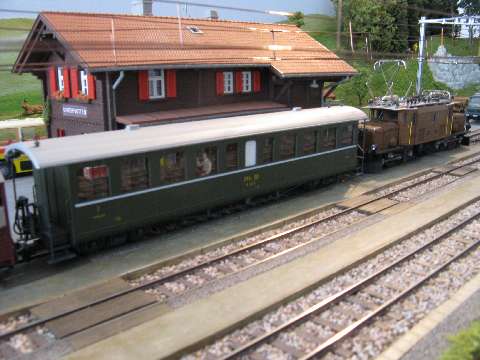
Roads are painted on
the cork, carefully filled with fine plaster where
needed and then weathered with fine shavings (using a
craft knife) from coloured pencils rubbed in with a
finger. The station building (with modified goods
platform) and the hotel (inspired by the Hotel Grischuna
at Filisur) are Kibri kits. A Fides kit
provides the toilet facilities and a Bemo ready-built
model is used for the Trafo (transformer) tower.
Figures of people etc are positioned sparsely so as not
to overcrowd the scene in a fairly remote setting and
because on protoype stations of this type passengers are
not allowed on the platform until the arrival of the
train. A bell unit (a D&R product) which
electronically synthesises the sound of the bells used
to inform of approaching trains, is housed under the
layout and has adjustable volume control.
The backscene was merely sky painted ply until last year when I could not stand the bareness any longer. Being unable to find a suitable commercially produced item I set to and painted a semblance of scenary in the distance using watered down poster paints. My crude effort and lack of artistic talent at least give me something better that a bare background to look at.
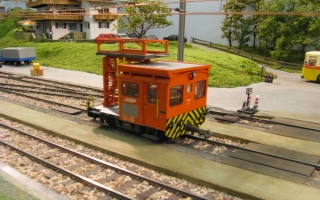
The traverser is fitted with six powered headshunts on each end, the idea being that trains could be reversed by driving off the train engine at one end and attaching a new loco at the other. On the longer headshunts it was envisaged that a wagon and loco could be exchanged. The idea is that 'what goes up can come down', but we have found that the time taken to swap locos slows things down, not offering enough train movements to the viewer at exhibitions. As it is, at shows we have eleven trains working to a sequence timetable with two of the traverser roads accommodating two short trains each and a railcar squeezing on to another road occupied by a three coach passenger train. Small file cards are used to list the stock and its road on the traverser to aid setting up. Full-length Albula line trains were obviously not possible in the space available, but judging from comments received from viewers a feel for the prototype has been achieved and now I have somewhere to run my stock.
I am greatly indebted to, and appreciative of, all those who help operate the layout at exhibitions and must thank Charlie Hulme for this and all his assistance with computer generated signs and displays etc.
UPDATE OCTOBER 2013
A train turntable has now been added to increase the variety and number of trains on the layout. Push pull trains merely return to the turntable whilst loco hauled ones pass through Untermutten crossing and swapping places with a train from a cassette (on track 1 of the traverser).
UPDATE NOVEMBER 2017
Untermutten and its stock has now been purchased by Ian and Helen Gould who would like to continue exhibiting it.
The backscene was merely sky painted ply until last year when I could not stand the bareness any longer. Being unable to find a suitable commercially produced item I set to and painted a semblance of scenary in the distance using watered down poster paints. My crude effort and lack of artistic talent at least give me something better that a bare background to look at.

The traverser is fitted with six powered headshunts on each end, the idea being that trains could be reversed by driving off the train engine at one end and attaching a new loco at the other. On the longer headshunts it was envisaged that a wagon and loco could be exchanged. The idea is that 'what goes up can come down', but we have found that the time taken to swap locos slows things down, not offering enough train movements to the viewer at exhibitions. As it is, at shows we have eleven trains working to a sequence timetable with two of the traverser roads accommodating two short trains each and a railcar squeezing on to another road occupied by a three coach passenger train. Small file cards are used to list the stock and its road on the traverser to aid setting up. Full-length Albula line trains were obviously not possible in the space available, but judging from comments received from viewers a feel for the prototype has been achieved and now I have somewhere to run my stock.
I am greatly indebted to, and appreciative of, all those who help operate the layout at exhibitions and must thank Charlie Hulme for this and all his assistance with computer generated signs and displays etc.
UPDATE OCTOBER 2013
A train turntable has now been added to increase the variety and number of trains on the layout. Push pull trains merely return to the turntable whilst loco hauled ones pass through Untermutten crossing and swapping places with a train from a cassette (on track 1 of the traverser).
UPDATE NOVEMBER 2017
Untermutten and its stock has now been purchased by Ian and Helen Gould who would like to continue exhibiting it.